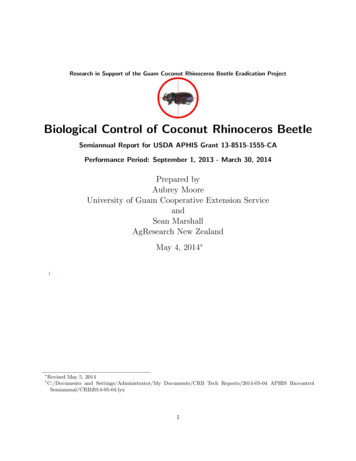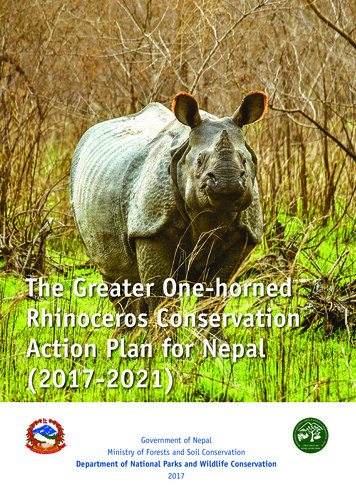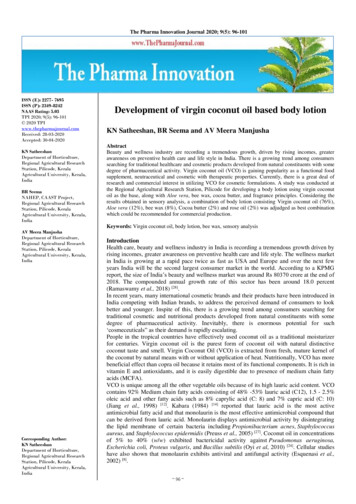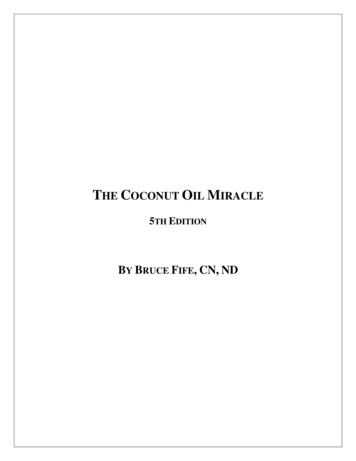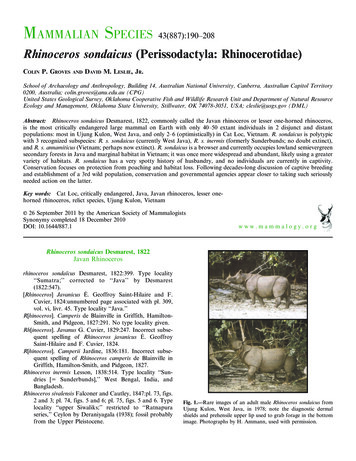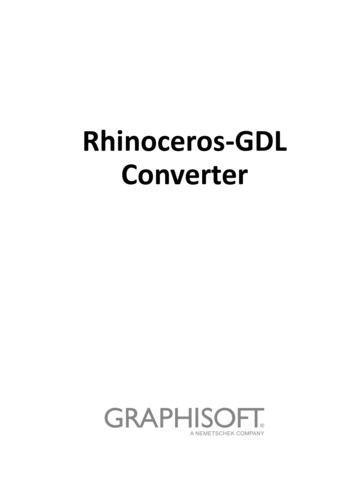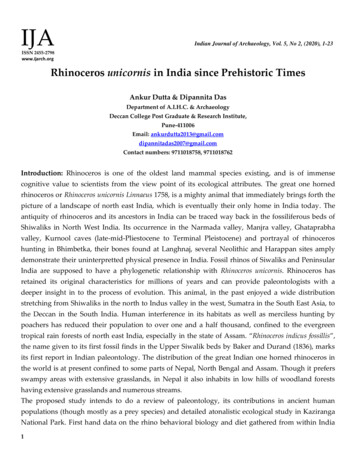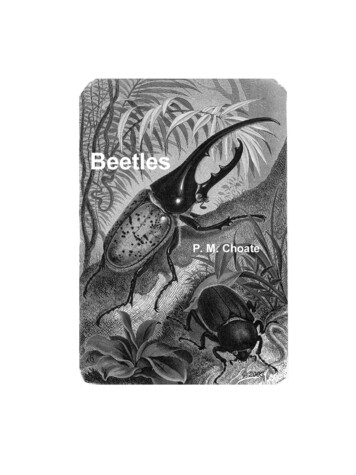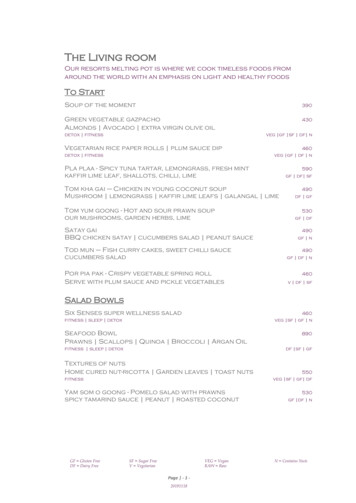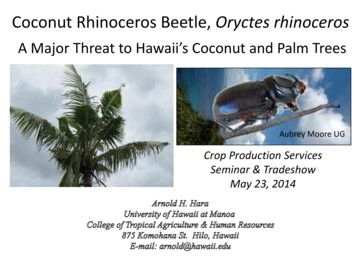
Transcription
Coconut Rhinoceros Beetle, Oryctes rhinocerosA Major Threat to Hawaii’s Coconut and Palm TreesAubrey Moore UGCrop Production ServicesSeminar & TradeshowMay 23, 2014
Topics to Be Covered*Coconut Rhinoceros Beetle-Known serious threat to Hawaii because of a severe CRB infestationin Guam since 2007-Discovery in Hawaii in Dec 2013-Attempt to eradicate the infestation Control strategies Physical Control (tub grinding infested mulch, bird netting) Chemical (pyrethroids and neonicotinoids) Heat (steam and hot water) Composting (In-vessel - heat and ammonia toxicity)*”Oahu's Banyan Trees Are Under Attack, Many Are Dying”By Denby Fawcett 05/13/2014 CIVIL BEAT“Two major insects are attacking and killing Oahu’s banyan trees.”Lobate Lac Scale (Serious pest in Florida began 10 years ago)Ficus Stem Gall Wasp (new to science)
LIFE CYCLE OF THE COCONUT RHINOCEROS BEETLE (CRB)Adult females lay eggs in deadcoconut palms, decaying organicmatter or mulch.Adults live 4 to 9 months; eachfemale lays 50 to 140 eggs duringher lifetime.Grubs (larvae) hatch in8 to 12 days fromwhitish brown eggs( 1/4” long) laid inorganic matter.Beetle feeding damage:hole bored into trunk(below); leaves with Vcuts (right)1-1/4 to 2-1/4” longGrubs feed on decomposedorganic matter for 82 to 207days, and grow from ¼” to 4”long (3 instars).Adult beetles remain in pupae for17- to 22 days, then emerge andfly to palm crowns to feed onexududed sap.Egg to egg-laying adult(132 to 282 days)1-1/2 to 2” longGrubs enter non-feeding prepupal stage for 8 to 13days usually in the soil; pupal stage lasts 17 to 22 days.
Coconut Rhinoceros Beetle (CRB)Native range: Southeastern Asia*CRB was introduced throughout the Pacific, primarily as a result of theincreased sea traffic during World War II.*Prior to discovery in Hawaii, CRB was discovered in Guam on Sep 2007.Female withshorter hornthan maleFemalewith fuzzyorangerearBores into live coconut and palms trees and feeds on exuding sap.
Distribution of Coconut Rhinoceros Beetle (CRB)Africa: Mauritius, Mayotte, and Reunion; Asia: Bangladesh, Brunei, Burma, Cambodia,Chagos Archipelago, China, Cocos Islands, India, Indonesia, Japan, Laos, Malaysia,Maldives, Philippines, Singapore, Sri Lanka, Taiwan, Thailand, and Vietnam; Middle East:Iran, Oman, Pakistan, and Yemen; Oceania: American Samoa, British Indian OceanTerritory, Fiji, Guam, Niue, Palau, Papua New Guinea, Samoa, Tokelau, Tonga, Wallis andFutuna.
Known HostsPreferred larval habitat is rotting Cocos nucifera (coconut)wood, followed by Artocarpus spp. (breadfruit), Calophylluminophyllum (kamani), Mangifera spp. (mango), and Pandanusspp. (hala). The larvae of O. rhinoceros feed on rotting organicmatter.Adults feed on several species of palm as well as coconut.Hosts of adults include:Major hostsCocos nucifera (coconut), Elaeis spp., and Elaeis guineensis(African oil palm).
Minor hosts for adultsAcanthophoenix rubra (barbel palm), Agave sisalana (sisal agave), Agave americana(American agave), Aiphanes horrida ( A. caryotifolia) (ruffle palm), Ananas spp.(pineapple), Ananas comosus (pineapple), Areca spp. (areca palm), Areca catechu(betel-nut palm), Arecastrum plumosa1, Arenga spp. (arenga palm), Arenga pinnata(sugar palm), Borassus spp. (borassus palm), Borassus flabellifer (palmyra palm),Caryota urens (fish-tail palm), Casuarina equisetifolia (Australian pine), Clinostigmasamoense ( Cyphokentia samoensis), Colocasia spp. (taro), Corypha spp. (gebang palm),Corypha umbraculifera (talipot palm), Corypha utan ( C. elata) (buri palm), Cyathea spp.(tree fern), Dictyosperma album (red palm), Dypsis pinnatifrons ( D. gracilis),Heterospathe elata var. palauensis, Hydriastele palauensis ( Gulubiopsis palauensis),Hyophorbe lagenicaulis ( Mascarena lagenicaulis) (bottle palm), Latania spp., Livistonaspp. (livistona), Livistona chinensis (Chinese fan palm), Metroxylon spp. (metroxylon),Metroxylon amicarum ( Coelococcus carolinensis) (Caroline ivory-nut palm), Metroxylonsagu (sago palm), Musa spp. (banana), Normanbya spp., Nypa spp., Nypa fruticans(nipa palm), Oncosperma spp., Pandanus spp. (pandanus palms), Pandanus tectorius(Tahitian screwpine), Phoenix spp. (date palm), Phoenix dactylifera (date palm), Phoenixsylvestris (wild date palm), Pinanga spp., Pinanga insignis ( Pseudopinanga insignis),Pritchardia pacifica (Fiji fan palm), Raphia farinifera ( R. ruffia) (raffia palm), Raphiavinifera (bamboo palm), Roystonea regia (royal palm), Saccharum spp. (sugarcane),Stevensonia spp., Thrinax spp. (thatch palm), Verschaffeltia splendida (Seychelles stiltpalm), and Wodyetia bifurcata (foxtail palm).
Coconut Rhinoceros Beetle (CRB) damage symptoms in Guam*Primary damage is adults boring from the petiolesof fronds into the crown cutting through developingunopen fronds feeding on the exuded sap.*V-shapecut onopenfronds.*Similar tomechanicalpruningdamage tounopenedfrondsActiveadultboringhole inpetiole;“Wetlook”Coconutfiberscaused byadultboringVisited Guam in Sept 2013 because ofa serious CRB threat to HIActive adult boring hole thru petiole
Beetles bore into frond stemand growing tips with their legs(tarsi, circled below) that arelined with very sharp, pricklyspines, to feed/suck on plantsap, not on foliage itself.PHEROMONE LURESmallmouthpartsUVLED
Damage to emerging Foxtail palm frondBoring with exposed coconut fiber
Major Breeding Site in Coconut Trimming Debris, Asan, Guam09/13
Major Breeding Site with all CRB stages, Asan, Guam
Asan BeachGuamDeadCoconutTree withCRBAdults andgrubs foundin rottingcoconut trunkterminalO9/13
Joint Base Pearl Harbor-Hickam Military FacilityMamala Bay Golf Course09/13 – CRB trap deployedat Hickam as part of USDApest survey for coconutpests not yet in Hawaii.12/23/13 - One coconutrhinoceros beetle (CRB)was caught in a trap aboutone mile from the infestedmulch pile at the edgeof the golf course. Infestedmulch included all stagesof CRB
Mamala Bay Golf Course(Hickam Air Force Base)*Coconut trees on golf course with CRBfeeding damage.*Golf course is near the internationalrunway w/military and commercial flightslanding and taking-off overhead.
Boring damage to folded new terminal growth: Damage is semi-circular
Area of attack by adult beetleLess recent adult boring holeOld boring holes through trunkAdult boring hole thru frond petiole
Adults and grubs found at the Mamala Bay (Hickam) Golf Course194 adults422 grubsInfested mulch pile was coveredwith bird netting to prevent adultemergence (January 11, 2014).
AEvolution of THE CRB TRAPBAggregationPheromoneA) Original design bucket coveredwith burlap; CRB pheromone lureaffixed to bucket lid; entry holesjust below the rim prevents beetleescape.B) Single bucket, BLACK vane,pheromone lure, solar UV lightC) Collection cup, black vane,pheromone lure, solar UV light(lighter, easier to deploy)C
More EfficientCRB Trap in GuamUV LED light50 gal steel barrel filledwith rotting coconutdebris, live CRB, grubs &aggregation pheromone.Ultraviolet LED light overtrap. Chicken wire allowsCRB to enter but cannotfly out.(Moore & Quitugua, per. com. 09/13)UV LED lightPheromonew/CRB
Latest Bucket Trap Design byUniversity of GuamLid with UV lightand entry holesCRB (L) Oriental Flower Beetle (R)pheromone lure
Oriental flower beetleIn Hawaii since 2002.Adult beetles active during the day (diurnal)Adult feeds on pollen, nectar, plant sap. Maydamage flowers of papaya, mango, coconut.adultCoconut Rhinoceros BeetleAdult beetles active at night (nocturnal)grubsingle, centered hornBody lengthup to 2.5”Largest beetleIn Hawaii.Body up to 1” lengthAdult moss green to reddish-black withwhite or metallic flecksCrawls straight orflips on its backCurls into a C-shape,crawls on its side
Coconut Rhinoceros Beetle InfestationSite2/21/14–Double ground mulch (2000 cu yd)with tub grinder.Mulch after double grindingTub grinderGrounded mulch spread andcovered with plastic and birdnetting.
Steaming Ground Mulch*Tarp steaming tested but penetrationwas slow, but has potential for smallermulch volume.Fabric steam pipesTemp recorderw/ laptopIn collaboration with Dominican University of California
Thermal Mortality of CRBConducted in collaboration with Dr.Michael Melzer (UH-CTAHR, PEPS100% MortalityBetween122 F for 10 minto 131 F for 5 minUntreatedambienttemp waterCRB grub borrowing into media
In-Vessel Composting to Heat Treat CRB-Infested MulchAerationpipesSpraying nitrogen solutionComposting Recipe. During composting, the limitingnutrient is often nitrogen and the target range fornitrogen is a carbon to nitrogen ration in the range 30:1to 60:1. If the nitrogen concentration is inadequate,the compost will not heat up. Nitrogen a concentratedsolution of urea and ammonium nitrate (total nitrogen3.54 pounds per gallon) is used. Temperature rises toVessels covered with air170 F and maintained for 4 days. Ammonia is alsoblowers operating (tarp istoxic.CRB grubs 100% mortality at 131 F for 5 mininflated).
Insecticide ControlConducted in collaboration with Derek Arakaki (HDOA)C*Studies in Guam indicatedthat cypermethrin (Demon) and the insect growthregulator, pyriproxyfen (NyGard) were effective against CRB.*Quick tests in Hawaii conducted with bifenthrin (Talstar), clothianidin (Arena),cypermethrin with and without the synergist, piperonyl butoxide (pbo).*Tests conducted by spraying insecticides directly on adults and grubs and bytreating mulch infested with adults and grubs.
PRODUCTACTIVE INGREDIENTAPPLICATIONRATENumber TreatedLARVAEADULTSTalstar P ProfessionalLiquid7.9% bifenthrindirect contact0.435 fl oz/gal(2 ml per insect)1010Talstar Xtra GCGranular0.05% Zeta-cypermethrin0.20% bifenthrinmulch treatment2.1 g /sq ft mulch,wetted with 40 mlwater154Talstar Xtra GCGranular0.05% Zeta-cypermethrin0.20% bifenthrindirect contact2.1 g/5 fl oz water(1 ml per insect)108Arena 50 WGD50.0% clothianidindirect contact0.008 g/6 fl oz water(2 ml per insect)105Demon WP40.0% cypermethrindirect contact0.33 fl oz/gal (0.1%)(1 ml per insect)10---Demon WP Exponent (synergist)40.0% cypermethrin 91.3% piperonyl butoxidedirect contact0.66 fl oz/gal (0.2%) 0.33 fl oz/gal(2 ml per insect)1010
45 minutes aftertreatment, Talstartreated beetleswere more activethan untreated.2 h 15 min after treatment,beetles were laying onbacks with legs twitching orTno movement.However, all treatedbeetles recovered frompoisoning after 48-72 hr.
*Pyrethroids did not kill all grubs; nogrubs were killed by neonicotinoidinsecticides.*Adults were paralyzed by pyrethroidsbut recovered after 48-72 hours.*Addition of piperonyl butoxide (pbo), asynergist, killed adults and grubsPyrethroid- treated adults are initiallyparalyzed (on backs with legs twitching)but recover after 48-72 hrrs.Live grubs used in tests
EFFICACY OF PESTICIDES ON Oryctes rhinoceros LARVAE AND ADULTS72 HAT (unless otherwise noted)4 DAT / 7 DAT*5 DAT(bifenthrin)(bifenthrin /cypermethrin)(clothianidin) (cypermethrin)*Demon WP Exponent: Adult mortality was 80% at 4 DAT(piperonylbutoxide)
Insecticide Treatment Needed in Crown Area to Prevent Adult AttackSymptoms of CRB Attack: V-cut with associated lateral boring thru fronds
“Two major insects are attacking and killingOahu’s banyan trees.”Ficus Stem Gall Wasp (new to science)Lobate Lac Scale (Serious pest in Floridabegan 10 years ago)
Injection Systems EvaluatedSidewinder Tree InjectorDelivers highest doseMauget Tree Injectors
Recent Stem and Leaf Gall Wasp StudiesBy B. Bhandari and Z. ChengUH-CTAHRDept. of Plant and EnvironmentalProtection Sciences*Emamectin benzoate injected with the Arborjet Quikjet wasmost effective against the stem gall wasp.*Imidacloprid and emamectin benzoate were 40-50%effective against the leaf gall wasp (Cheng, personalcommunication).*Imidacloprid was effective against the Lobate Lac Scale.
Lobate lac scaleParatachardina pseudolobata*First time in Florida on a hibiscus in August 1999.First inHawaii Oct 2012 on Ficus, Moanalua Park.*Occurs in Florida, Bahamas and Christmas Island.*Produces honeydew which supports sooty mold growth.*Host range of over 307 species of woody plantsincluding Fabaceae (Acacia), Malvaceae (Hibiscus)Moraceae (Ficus), Myrtaceae (Eugenia, guava),rose,gardenia, Phoenix palm.*Belongs to the lac scale family from which shellac isproduced.“The potential for further spread of this scale isespecially high for warm areas into which there is asignificant movement of living plants e.g., fromFlorida to Puerto Rico, and other localities of theCaribbean Region, California and HAWAII.” (Howardet al. 2002).
*One drench application of Merit75 WP (imidacloprid) to largeIndian Laurel Tree, Ficusretusa, eradicated lobate lacscale for over a year (523days).*Foliar applications of imidaclopridand bifenthrin (Talstar) werealso highly effective againstcrawler and adult stages oflobate lac scale.(Research in Florida by Howard &Steinberg 2005)Hawaii Dept. of AgriculturePlant Pest Control BranchWalter Nagamine, Darcy Oishi,Bernarr Kumashiro, JanisGarcia
Belongs to the lacscale family fromwhich shellac ismade.
Red Imported FireAnt infestation atMiramar MarineAir Station, SanDiego, CAWill it establish atKaneohe MarineAir Station?RedImportedFire Ant02/14
Conclusions?
THANK YOU!Research Support Staff:Ruth Niino-DuPonteSusan CabralKyle OnumaJorden ZardersCollaborators:Derek Arakaki, HDOA, PPCChris Kishimoto, HDOA, PQMichael Melzer, UH-CTAHRFunding:Farm BillUSDA, APHISHawaii Dept. of Agriculture08 Feb 14
Coconut Rhinoceros Beetle Body length up to 2.5” Largest beetle In Hawaii. 2/21/14 –Double ground mulch (2000 cu yd) with tub grinder. Tub grinder Coconut Rhinoceros Beetle Infestation Site Mulch after double grindin
